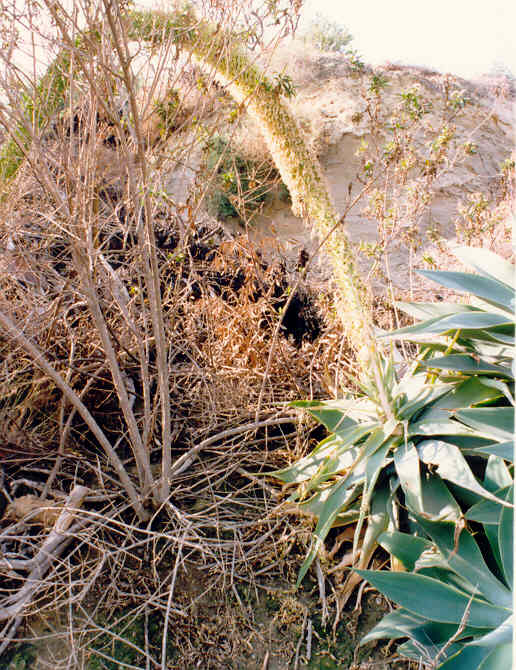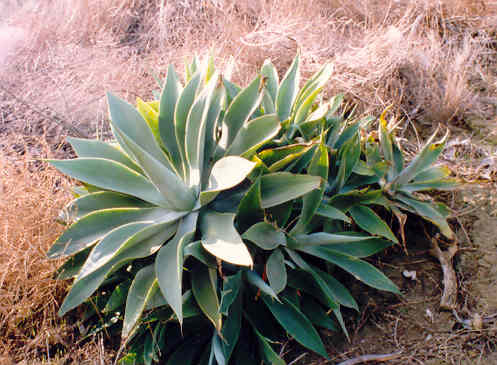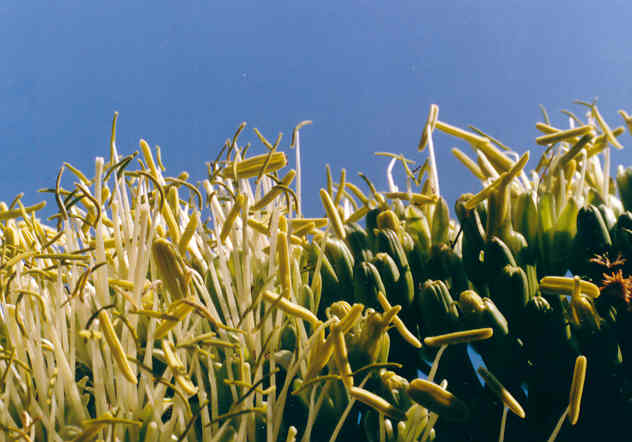
Agave attenuata Salm-Dyck.
 |
Agave attenuata Salm-Dyck.
Liliaceae (Lily Family)Tropical AmericaAgave |
January Photo
Plant Characteristics:
Succulent, growing in clumps to 5 ft. across, older plants develop a
stout trunk to 5 ft. tall; leaves to 2.5 ft. long, soft green or gray green,
fleshy, somewhat translucent, no spines; fls. greenish-yellow, dense on arching
spikes, to 12-14 ft. long.
Habitat:
Good near ocean or pool in S. Calif.
Will be burned by hot sun and damaged by heavy frost.
(Sunset Editors, New Western Garden Book, 1984. 171).
Three hundred or more species of striking plants, in the arid and
semi-arid trop. parts of the western hemisphere.
(Bailey 238).
Name:
Greek, agave, noble or
admirable. (Munz, Flora
So. Calif. 864). Attenuata,
produced to a point. (Bailey 11). Attenuata refers to
the leaf tips which are produced to a point.
(John Johnson).
General:
Uncommon in the study area, found as an escape from cultivation.
Plants, such as the photographed specimen, that occur on the lower bluff
were probably thrown there as cuttings from gardens above. (my comments).
After flowering, which may take years, the foliage clump dies, usually
leaving behind suckers which may make new plants. Drought resistant, the plants shrivel from serious lack of
water but plump up again when watered or rained on.
(Sunset Editors, New Western Garden Book, 1984. 171).
The sap of the leaves and inflorescence are toxic.
Fresh juice of the plant is cathartic and diuretic.
The juice of the leaf and particularly the outer layers of the leaf are
highly irritant to the skin. (Fuller
265). The
leaves and roots of Agave spp. contain
sapogenins, hecogenin and tigogenin, soapy substances used in manufacturing
steroids. A teaspoon of the
expressed leaf sap or one-fourth ounce of the dried leaf boiled in a tea helps
indigestion, stomach fermentation, and chronic constipation.
The fresh sap is used for burns, cuts, and skin abrasions.
The root, fresh or dried, makes a useful soap and, like yucca, has been
used for arthritis. (Moore, Medicinal
Plants of the Mountain West 19).
A family of about 19 genera and 500 species, usually put partly in Liliaceae and partly in Amaryllidaceae.
(Bailey 237). Agavaceae
has been included in Liliaceae in the
new Jepson Manual. (Hickman,
Ed. 1170).
Text Ref:
Sunset Editors, New Western Garden Book, 1984. 171.
Photo Ref:
May 1 88 # 24; Sept-Jan 90,91 #19,20,21,22.
Identity: by R. De Ruff.
First Found: January 1991.
Computer Ref: Plant Data 357.
No plant specimen.
Last edit 5/27/04.
 |
 |
January Photo January Photo